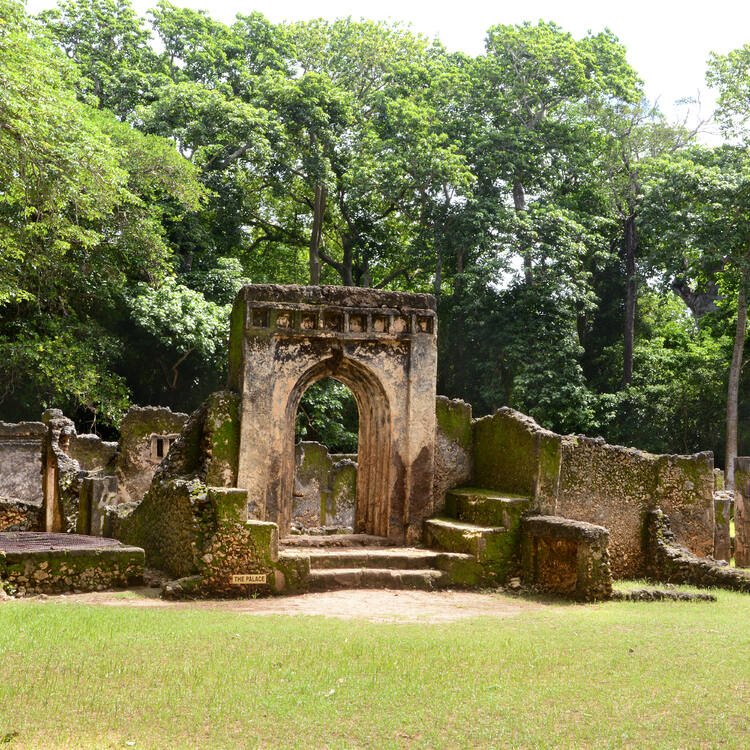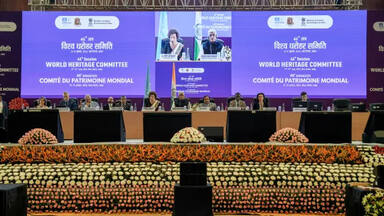The Historic Town and Archaeological Site of Gedi
The Historic Town and Archaeological Site of Gedi
Surrounded by a remnant coastal forest, away from the coastline, the abandoned city of Gedi was one of the most important Swahili cities on the East African coast from the 10th to 17th centuries. During this period, it was part of a complex and international network of trade and cultural exchanges that crossed the Indian Ocean, linking African coastal centres with Persia and other areas. The opulent settlement is clearly delineated by walls and features remains of domestic, religious, and civic architecture, and a sophisticated water management system. It strongly represents the characteristics of Swahili architecture and town planning, utilising materials such as coral rag, coral and earth mortar and wood.
Description is available under license CC-BY-SA IGO 3.0
La ville historique et site archéologique de Gedi
Entourée d’un reste de forêt côtière, à distance du littoral, la ville abandonnée de Gedi fut l’une des plus importantes villes swahilies de la côte de l’Afrique de l’Est entre le Xe et le XVIIe siècle. Durant cette période, elle fit partie d’un réseau complexe et international d’échanges commerciaux et culturels à travers l’océan Indien, reliant les centres côtiers africains à la Perse et à d’autres régions. Cet établissement opulent est clairement délimité par ses murs d’enceinte et présente des vestiges d’architecture domestique, religieuse et civile, ainsi qu’un système de gestion de l’eau élaboré. Il présente clairement les caractéristiques architecturales et urbanistiques swahilies, faisant usage de matériaux tels que le calcaire corallien, le corail, le mortier de terre et le bois.
Description is available under license CC-BY-SA IGO 3.0
مدينة جيداي التاريخية وموقعها الأثري
source: UNESCO/CPE
Description is available under license CC-BY-SA IGO 3.0
格迪古镇和考古遗址
source: UNESCO/CPE
Description is available under license CC-BY-SA IGO 3.0
Исторический город и археологический памятник Геди
В период с X по XVII век ныне заброшенный город Геди был одним из важнейших городов народа суахили на побережье Восточной Африки. Он расположен в окружении остатков прибрежного леса, вдали от береговой линии. В указанный период он был частью сложной международной системы торгового и культурного обмена, пересекавшей Индийский океан и связывавшей прибрежные центры Африки с Персией и другими регионами. Это некогда богатое поселение четко очерчено стенами. В нем сохранились остатки жилищной, религиозной и гражданской архитектуры, а также сложной системы управления водными ресурсами. В облике города четко прослеживаются черты суахилийской архитектуры и градостроительства, с применением таких материалов, как коралловый известняк, коралловой и земляной раствор, а также дерево.
source: UNESCO/CPE
Description is available under license CC-BY-SA IGO 3.0
Ciudad histórica y sitio arqueológico de Gedi
La ciudad abandonada de Gedi, que está rodeada por los vestigios de un bosque costero y alejada del litoral, fue una de las ciudades suajili más importantes de la costa oriental africana entre los siglos X y XVII. Durante este periodo, formó parte de una compleja red internacional de intercambios comerciales y culturales que cruzaba el océano Índico y unía los centros costeros africanos con Persia y otras áreas. El opulento asentamiento está claramente delimitado por murallas y presenta restos de arquitectura doméstica, religiosa y cívica, así como un sofisticado sistema de gestión del agua. Representa fielmente las características de la arquitectura y el urbanismo suajili, utilizando materiales como la caliza coralina, el mortero de coral y tierra y la madera.
source: UNESCO/CPE
Description is available under license CC-BY-SA IGO 3.0
Outstanding Universal Value
Brief synthesis
The Historic Town and Archaeological Site of Gedi was one of the most important and densely populated Swahili cities on the East African coast in the period from the 10th to 17th centuries (and particularly between the 15th and 17th centuries). During this period, Gedi was part of a complex network of trade and cultural exchanges that crossed the Indian Ocean, linking African coastal and inland centres with ports around the Arabian Sea and Southern Asia. Because Gedi was abandoned, its surviving ruins strongly demonstrates the characteristics of Swahili architecture and town planning.
Gedi was an opulent settlement, defined by two rings of irregularly running walls, public and private buildings, street patterns, tombs, and an elaborate palace complex and Grand Mosque. Within the inner walls, the remains of domestic, civic and religious architecture, all constructed from local coral stone and lime mortar, are laid out around a grid street pattern, with the mosques and tombs embellished by carvings and inset with Chinese porcelain. Between the inner and outer walls, there is evidence of more modest houses built for the majority of the residents. The city was serviced by wells and a sophisticated water engineering and management system that is still readable.
Luxury goods imported from China, Persia, India, and Venice found at Gedi demonstrate its role in international trade networks, that were supported by the export of gold, ivory, and other minerals and timber, as well as slaves. Gedi is located inland, 6.5 kilometres away from the Indian Ocean coastline and is surrounded by a remnant coastal forest. Gedi is well-researched, and has the potential to contribute further to the understanding of Swahili coastal settlements and trading histories.
Criterion (ii): The Historic Town and Archaeological Site of Gedi exhibits an important interchange of values on architecture, technology and town-planning as a result of its participation over several centuries in the Indian Ocean trading system between the East African coast, the Arabian Sea and Southern Asia. The fusion of African and Islamic beliefs can be seen in the layout of the city, in the distinctive architectural forms of its coral stone buildings, in the decorative details of its mosques and tombs, and in the technical know-how of the wells and hydraulic systems that sustained a large urban settlement over centuries of occupation.
Criterion (iii): The Historic Town and Archaeological Site of Gedi bears exceptional testimony to the strong Swahili cultural traditions that developed and flourished as a result of maritime trade between the East African coast and the Indian Ocean from the 10th to the 17th centuries. Gedi was a substantial urban settlement with outstanding features of town planning, architecture, and infrastructure. It is distinctive for the scale and density of its urban settlement, unusual and complex spatial layout, and intricate water engineering.
Criterion (iv): The Historic Town and Archaeological Site of Gedi is an outstanding example of a Swahili settlement from the 10th to the 17th centuries, that reflects a period when the East African coast became part of a global trading network linking Eastern Africa across the Arabian Sea and the Indian Ocean with India and Southern Asia. Gedi is one of the largest, most well-preserved and well-researched abandoned Swahili Islamic settlements on the East African coast. The architectural and archaeological elements of Gedi demonstrate its opulence, as well as its social stratification.
Integrity
The boundaries of the property are well-defined and contain all the attributes of the historical town including the inner and outer walls, water infrastructure and wells, tombs, mosques, sunken courts, palace, private houses, streets, and alleyways. The attributes are well-documented and the structures and archaeological materials are generally in a good state of conservation, although they are vulnerable and require monitoring and maintenance. Traditional building materials and methods were used for the maintenance of the structures. The visual integrity of the site is also good, due to the protection provided by the surrounding remnant African coastal forest in the buffer zone which is managed with the support of the Kenya Forest Service.
Authenticity
Gedi is an abandoned settlement with standing walls and buried archaeological remains. The abandonment of the settlement and lack of subsequent occupation has ensured a high level of authenticity. The remains of buildings and walls are in their original location, and the town layout is evident. The water sumps and other infrastructure elements are in place. The original building materials have been respected in the conservation works undertaken, and all works are documented. Appropriate conservation measures are in place and a detailed Conservation Management Plan for Gedi is in preparation that should further support the authenticity of the property.
Protection and management requirements
The property has been subject to legal protection since 1927 and is a National Monument protected by the Kenyan National Museums and Heritage Act (2006). The natural values of the surrounding forest are also protected by Kenyan law. At the local level, Gedi is additionally protected through the County Integrated Development Planning processes, and the Spatial Development Framework. All developments within the property and the buffer zone require permission from the National Museums of Kenya and are subject to Heritage Impact Assessment processes.
Gedi is managed by the National Museums of Kenya in cooperation with the Malindi Museum, relevant national and local authorities, and the local community. A management plan (2022-2027) and action plan are in place, and were prepared in cooperation with major stakeholders and the local community. Gedi is vulnerable to fire, and fire management and training are priorities for the disaster risk preparedness plan which is being prepared. Further development of strategies and plans for visitor management, sustainable tourism, archaeological research, interpretation and conservation are planned. The management plan includes actions for capacity building and the transfer of traditional skills. Adequate monitoring is in place, although this should be further augmented by regular monitoring of vegetation, and the development of more specific indicators that can track trends and identify emerging issues.


